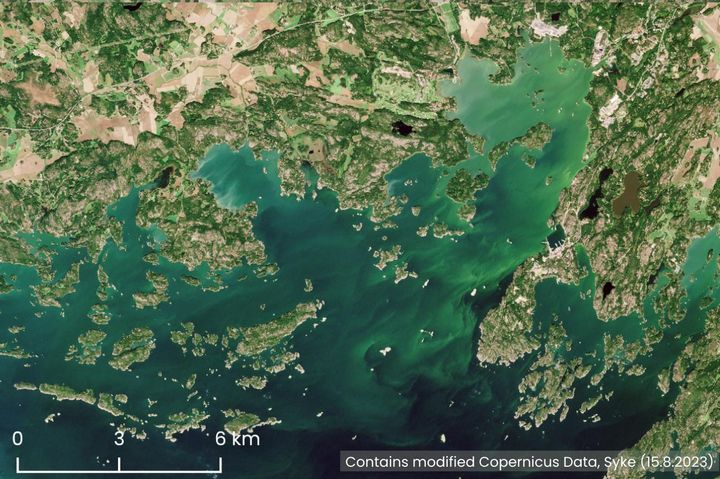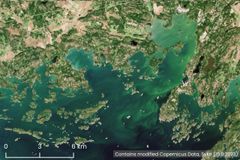Blue-green algae situation has remained stable both in lakes and at sea
Blue-green algae observations in lakes and coastal areas have increased slightly since last week. However, the situation is normal for the season and, in lakes, even better than usual. In sea areas, blue-green algae close to the surface have been observed mainly in the eastern parts of the Gulf of Finland. Elsewhere in the open sea, blue-green algae are mixed with water.

Link to the map
Map of the national blue-green algae monitoring observations on week 33
More in Finnish
Sinilevätilanne pysynyt tasaisena niin järvillä kuin merellä
Syke observes the cyanobacteria occurrence as part of the monitoring of the state of the environment in Finland
The national cyanobacterial monitoring is carried out as part of the monitoring of the state of the environment in cooperation with the Centres for Economic Development, Transport and the Environment, municipal environmental and health authorities, and the Finnish Environment Institute (Syke). Finnish Rotary Clubs are also actively involved in nationwide cyanobacterial monitoring.
The cyanobacterial monitoring is based on the monitoring of cyanobacterial deposits in surface water. The intention is to provide an overview of the cyanobacterial situation in different water bodies. The monitoring includes about 400 permanent observation sites across the country on inland and coastal waters and in the archipelago.
Information on the cyanobacterial situation in the open sea areas is mainly obtained from satellite images, but also from the Finnish Border Guard, the marine research vessel Aranda, the optical device located at the Utö Atmospheric and Marine Research Station, as well as cruise and merchant ships (MS Finnmaid and MS Silja Serenade) equipped with Alg@line measuring equipment. The drift forecasts for cyanobacterial rafts in open sea areas are prepared in cooperation with the Finnish Meteorological Institute's Maritime Services.
Syke reports on the national cyanobacterial situation on a weekly basis every Thursday from the beginning of June until the end of August. The weekly algal reporting was launched in 1998.
Several compounds produced by cyanobacteria can cause health hazards
According to the Finnish Institute for Health and Welfare (THL), cyanobacterial occurrences can cause health hazards. Cyanobacteria produce a number of different compounds that can cause symptoms. Some cyanobacteria can produce liver or nerve toxins, but most of the symptoms experienced by swimmers may also be due to other compounds.
Small children and pets should particularly be kept out of water rich with cyanobacteria. Water with cyanobacteria should not be used in a sauna or as washing or irrigation water.
If you suspect a poisoning, seek medical advice, or take the pet to a veterinarian. If necessary, the Poison Information Centre will provide additional instructions.
The municipal health authorities monitor the cyanobacterial situation on beaches.
More information about blue-green algae and health:
- At the the Finnish Institute for Health and Welfare (THL) website
- At the Poison Information Center website
Report your cyanobacterial observations to the Järvi-meriwiki (Lake and sea wiki)
In Järvi-meriwiki, maintained by the Finnish Environment Institute, you can establish your own observation site and share cyanobacterial observations or make individual observations when moving around waterways. You can also report observations via the smartphone-friendly Havaintolähetti website.
The reported observations are shown on the national cyanobacterial observation map, and they support the national algal situation assessment. Observations about the absence of cyanobacteria are also important.
Järvi-meriwiki is an online service produced in collaboration with authorities and citizens. The service provides basic information on all lakes larger than one hectare as well as different areas of the Baltic Sea. Users can share, for example, photos and other observations on the service.
Municipalities and cities monitor the cyanobacterial situation on the beaches, so it is advisable to report rich cyanobacterial occurrences on beaches to the health authorities of the municipality in question.
This is how you identify cyanobacteria
A small amount of cyanobacteria in the water appears as green or yellowish particles. Narrow stripes of algae can drift to a beach. In calm weather, a substantial amount of cyanobacteria forms greenish or yellowish algal rafts and piles up in coastal water. In spring, yellowish pollen from coniferous trees may also be present in the water. Unlike cyanobacteria, pollen is found not only on the surface water but also, for example, on piers or yard furniture.
Cyanobacteria dissolve into tiny particles in the water if you touch the algal mass with a stick. If the algae become attached to the stick, they are something other than cyanobacteria. In a water vessel, cyanobacteria rise to the surface as tiny greenish particles within about an hour.
- Read more: How do you recognize blue-green algae?
Cyanobacterial observations also in the MarineFinland.fi and Waterinfo.fi services
The cyanobacterial maps presented on the websites MarineFinland.fi and Waterinfo.fi combine the observations reported to the Järvi-meriwiki and from the beaches of the City of Helsinki, as well as the observations based on satellite interpretations made by Syke during the last three days.
Keywords
Contacts
Inquiries about blue-green algae situationTelephone 1 pm to 3 pm
Lakes: Tel +358 50 5734 347 or +358 295 251 326
State of the Baltic Sea: Tel +358 50 5693 297 or +358 295 251 314
Satellite observations: Tel 358 50 4707 576 or +358 295 251 329, e-mail: Eotuki@syke.fi
Tytti JuustiCommunications Intern
Tel:+358 295 252 323firstname.lastname@syke.fiEija JärvinenCommunication Specialist
Tel:+358 295 251 242firstname.lastname@syke.fiImages

Links
It is time to move beyond solving environmental problems one by one, to systemic sustainability transformations. The Finnish Environment Institute (Syke) contributes to building a sustainable society through research, information and services. The Finnish Environment Institute is a research institute with 700 experts and researchers located in Helsinki, Oulu, Jyväskylä and Joensuu.
Subscribe to releases from Suomen ympäristökeskus
Subscribe to all the latest releases from Suomen ympäristökeskus by registering your e-mail address below. You can unsubscribe at any time.
Latest releases from Suomen ympäristökeskus
Viikkokatsaus 24.–28.11.202520.11.2025 11:57:48 EET | Tiedote
Hei! Tässä tiedoksesi meillä Suomen ympäristökeskuksessa ensi viikolla ilmestyviä tiedotteita, uutisia, kampanjoita, blogeja ja uutiskirjeitä. Mukana myös tulevia tapahtumia ja webinaareja. Jakelemme viikkokatsauksen torstaisin STT:n kautta. Koosteet löytyvät myös STT-uutishuoneesta, josta voit tilata kaikki Suomen ympäristökeskuksen tiedotteet.
Proposal for saving the Baltic Sea: 34 actions to strengthen the network of marine protected areas18.11.2025 10:00:00 EET | Press release
Joint press release from Metsähallitus and Finnish Environment Institute Baltic Sea nature is threatened by eutrophication, pollution and climate change. The Roadmap for the development of marine protected area network in Finland until 2030, which was drawn up in cooperation between a number of organisations, presents 34 actions for improving the status of the Baltic Sea, safeguarding the most valuable marine areas and achieving international conservation area targets. Never before has an equally extensive and comprehensive plan for the conservation of marine nature been drawn up in Finland.
Plan för att rädda Östersjön: 34 åtgärdsförslag för att stärka nätverket av marina skyddsområden18.11.2025 10:00:00 EET | Pressmeddelande
Forststyrelsen och Finlands miljöcentral meddelar: Östersjöns natur hotas av eutrofiering, föroreningar och klimatförändringen. Färdplan för utvecklingen av Finlands nätverk av marina skyddsområden fram till 2030, som utarbetats i samarbete mellan flera organisationer, innehåller 34 konkreta åtgärder för att förbättra havets tillstånd, skydda de mest värdefulla havsområdena och uppnå internationella mål för skyddsområdena. En så omfattande och heltäckande plan för skydd av den marina naturen har aldrig tidigare tagits fram.
Suunnitelma Itämeren pelastamiseksi: 34 toimenpide-ehdotusta merensuojelualueverkoston vahvistamiseksi18.11.2025 10:00:00 EET | Tiedote
Suomen ympäristökeskus ja Metsähallitus tiedottavat: Itämeren luontoa uhkaavat rehevöityminen, saastuminen ja ilmastonmuutos. Useiden organisaatioiden yhteistyönä laadittu Suomen merensuojelualueverkoston kehittämisen tiekartta vuoteen 2030 esittää 34 konkreettista toimenpidettä, joilla voidaan parantaa meren tilaa, turvata arvokkaimmat merialueet ja saavuttaa kansainväliset suojelualuetavoitteet. Yhtä laajaa ja kattavaa suunnitelmaa meriluonnon suojelusta ei ole aiemmin tehty.
Viikkokatsaus 17.–21.11.202513.11.2025 12:45:29 EET | Tiedote
Hei! Tässä tiedoksesi meillä Suomen ympäristökeskuksessa ensi viikolla ilmestyviä tiedotteita, uutisia, kampanjoita, blogeja ja uutiskirjeitä. Mukana myös tulevia tapahtumia ja webinaareja. Jakelemme viikkokatsauksen torstaisin STT:n kautta. Koosteet löytyvät myös STT-uutishuoneesta, josta voit tilata kaikki Suomen ympäristökeskuksen tiedotteet.
In our pressroom you can read all our latest releases, find our press contacts, images, documents and other relevant information about us.
Visit our pressroom